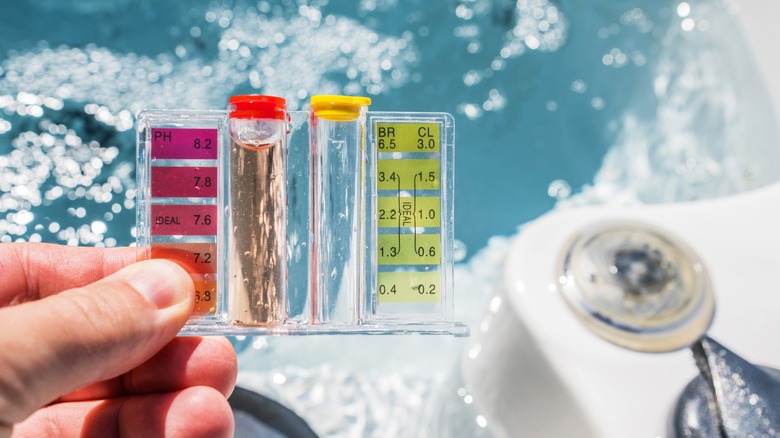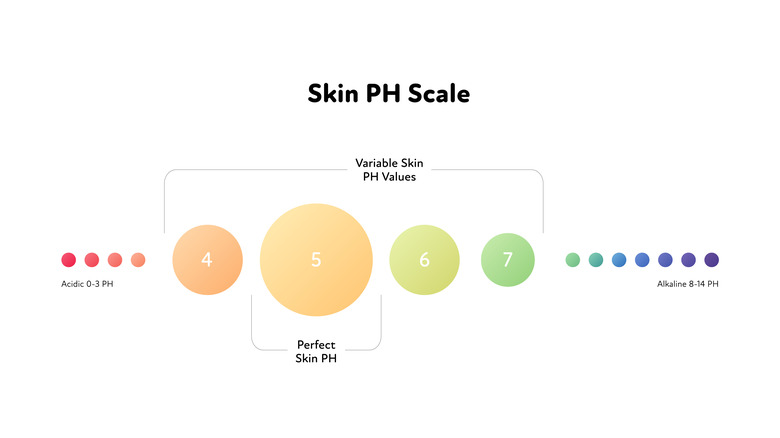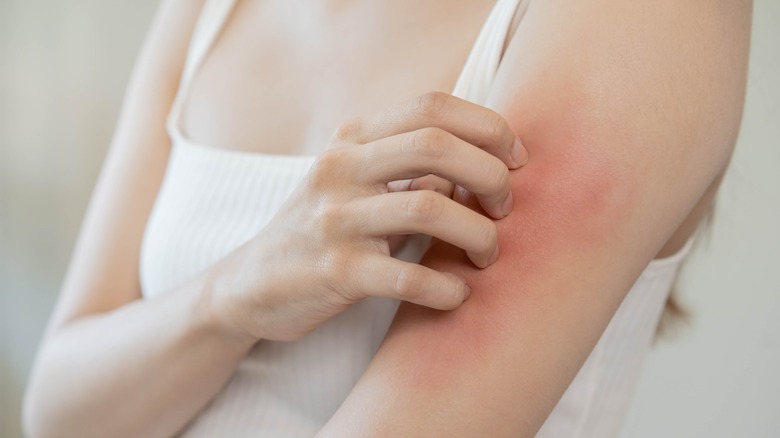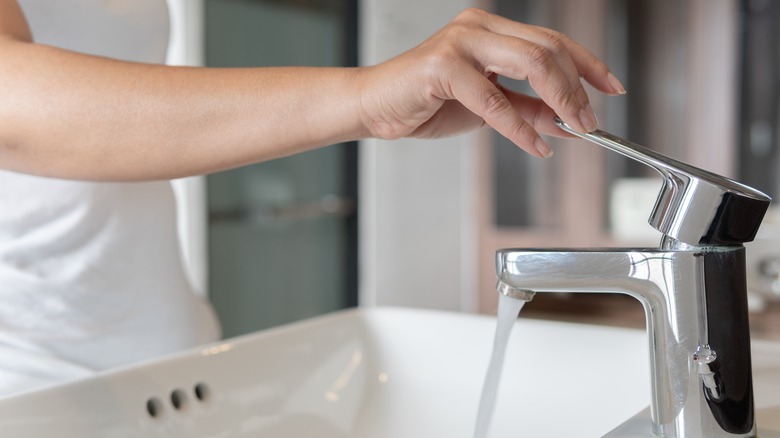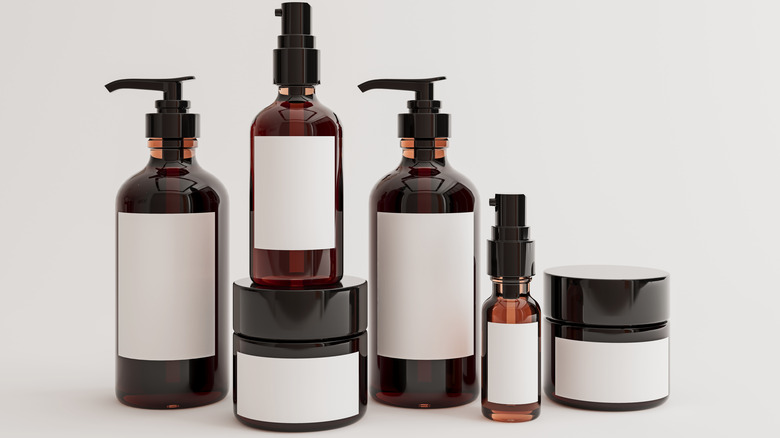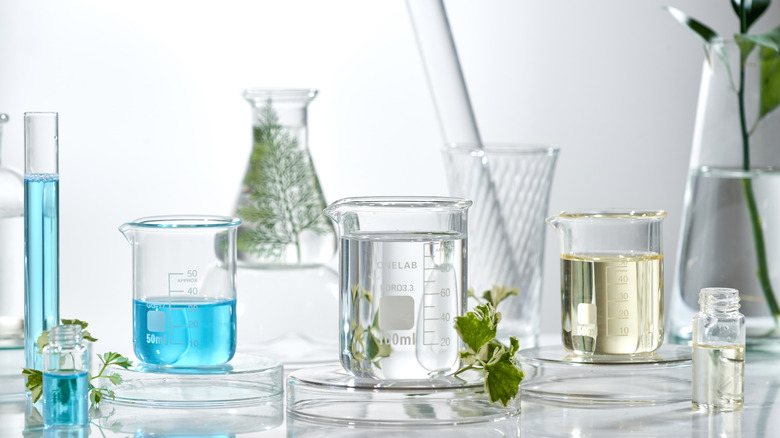Everything You Need To Know About Your Skin's pH
Skincare fads come and go — and some we're so glad to have gone. But in the last year or so there's been talk about skin pH and how it affects skin. Every brand and company has seemed to jump on the bandwagon to create products that attempt to balance your skin's pH levels — or at least help your skin without unbalancing the pH. Maybe you've tried a few products and didn't notice any difference — or maybe you noticed a difference but it wasn't positive.
The good news? Skin pH is not a new idea. Our skin has always naturally had a pH level and we've always been dealing with it, whether we realized it or not. Your skin's pH is important to get right and can create uncomfortable consequences if you mess with it too much or in the wrong way. Acne, dryness, and irritation can all be side effects of an imbalanced pH level on your skin. But it doesn't all have to do with skin irritations or conditions, as the skin's pH can also affect your overall health.
And here's the thing: Your skin's pH levels can be balanced both internally and externally, and it doesn't have to mean buying expensive products. In fact, you might already have most of the items you need to balance your pH and finally wrangle your skin into submission.
What is a pH level?
The term "pH" stands for "potential of hydrogen" and refers to how the acidity of substances or surfaces is measured. It does this by taking into consideration the activity of the hydrogen ions in a water-based solution. Since hydrogen makes up two-thirds of water, there will always be some kind of activity to be measured.
The scale for pH ranges from 1 to 14, with 1 being the most acidic and 14 being the least acidic, or alkaline (also referred to as basic). The middle (7) is the neutral figure, and this is also the pH measurement of water when it's pure.
Also, the pH scale is logarithmic, not linear. To understand this scale, you have to think about the fact that while the numbers on the scale might seem minuscule, they have a tenfold increase times 10 between each number. So, a reading of 3 on the scale is, in fact, 100 times more acidic than a reading of 5. This is why it's a big deal for something to be even one number of measurement different than what it should be. We use pH to measure the acidity or alkalinity of everything in the world, including water and blood. It's used throughout the fields of agriculture, biology, chemistry, and, of course, the skincare field.
Our skin has a pH level
According to the Journal of Biological Chemistry, human skin is made up of 64% water. Our skin, therefore, has a pH measurement, like most things in the world that contain liquid (water). Our skin is made up of a total of water, protein, fats, and minerals.
Here's the surprising fact: Our skin does not have a neutral pH like some might think. It actually rests somewhere in the 4 to 6 range, meaning that it is acidic, and the exact number will vary a bit with the different locations of our body that the measurement is taken at or the age that we're at when we're measured. Newborns have a pH closer to neutral, around 7, and that pH number drops quickly as they age. The older you get, the more acidic your skin becomes but those numbers drop as you age.
Healthline compares the ideal acidity of our skin with that of black coffee, explaining that we should aim for a "weakly acidic" pH for our skin. Studies have also found that women's skin tends to be more acidic than men's skin with an average difference of about 0.30 on the pH scale.
The acid mantle
The term "acid mantle" was coined more than 90 years ago by German scientists, according to the journal Current Problems in Dermatology. The acid mantle is used to describe a very thin film that's present on the top of our epidermis and acts as the first level of defense for our skin, according to board-certified dermatologist Sandra Lee (via Good Housekeeping).
The pH of your skin is calculated based on this thin film, which is made up of a combination of sebum, the natural oil that's secreted by our sebaceous glands, and our sweat. "The acid mantle's composition is slightly acidic, due to the combination of the amino acids from sweat and the triglycerides, fatty acids, and wax esters contained in the sebum," says Dr. Marie Hayag (via Good Housekeeping).
Among the things the acid mantle protects against include bacteria, degradation of the microbiome on our skin (the good bacteria), and the disruption of vital biological processes. There are both internal and external factors that can disrupt the composition of the acid mantle and cause problems for our skin.
How fluctuations in pH affect our skin
So we've gone through and learned all about pH, but does it really even matter for our skin that much? Does a little difference in acidity here and there make enough of a difference for companies to warrant selling products that will "fix our acid mantle" or "balance pH?"
Some big signs of our skin's pH not being quite where it should include dryness, itchiness, breakouts, and tight or sensitive skin. That doesn't sound like no big deal to us. Plus, these changes are usually signs that your skin's acid mantle barrier has been damaged or destroyed and that's why the pH is all out of sorts and your skin's reacting.
And as if breakouts and dryness weren't enough, Dr. Marnie Nussbaum, a board-certified dermatologist based in New York City, says, "A study published in the British Journal of Dermatology by Greg Hillebrand, Ph.D., revealed that patient's skin which was too alkaline (their pH balance was too high) developed more fine lines and crow's feet than those with acidic skin (their pH was balanced)" (via Byrdie). Translation: An imbalanced pH can even lead to premature signs of aging such as wrinkles. This means that one of the easiest ways to keep your skin from aging, or looking aged, is to maintain a pH balance of around 5.5, considered the ideal pH by most doctors.
External factors that affect our skin's pH
To maintain this pH level, we have to think about both the internal factors that affect our pH levels and the external factors. Let's talk about the external factors that we have to deal with. Some are harder to change and some are easier — cleansers (really, anything you apply to your face), detergents, antibacterial products, and even the levels of pollution in the air can affect or change the pH level of your skin. In fact, Everyday Health explains that the rise in popularity of pH balanced products began with Korean beauty products since many Koreans contribute their sensitive skin to their air pollution.
Looking at these, the types of products that you put on your skin would be pretty simple to change or to double-check that they aren't messing with your acid mantle. Think about not only your facial skin but also your skin overall — if you have sensitive skin all over your body then you'll want to make sure that everything that touches you is double-checked and okayed before you proceed to the next step.
Environmental triggers can be harder to deal with. Weather can even be a trigger for you, especially if you live in an overly dry area or you have a job that requires you to be outside and exposed to potential UV damage for long stretches at a time. Think about also what you touch or use on a daily basis — do you use a lot of antibacterial gels or creams that would break down your microbiome or do you interact with chemicals that are drying or damaging to your skin? These are things to consider when thinking externally, and what you can do to counter-balance certain elements.
Does tap water affect our skin's pH?
There is still much back and forth about the possibility of tap water affecting the pH of our skin. Some warn about tap water being bad for your skin since the pH of water is usually around 7, while our skin's pH should be more around 5 when it's healthy. That's not even taking into consideration the kinds of pollutants that could be in your tap water. Naturopath Trevor Cates tells Everyday Health that tap water that's 'hard' can cause an alkaline environment on our skin and lead to troubles.
Other skincare experts say that there's no reason you shouldn't be able to wash your face with the water from your sink (as long as you know it's not polluted). Since the pH of water is a neutral pH, the it shouldn't be disruptive to your skin's pH — and, at the very least, it will be less disruptive than any other product that has a different pH.
Healthy skin should bounce back pretty quickly, even after being exposed to a different pH than it's own, says Renee Rouleau, skincare expert and esthetician who has created products used by celebrities like Demi Lovato. If you're concerned about your tap water having an effect on your skin, you could try one of a number of other ways to clean your face while staying away from tap water. Distilled water and pasteurized milk are options, as are micellar water and sparkling water because it has a lower pH than tap water.
How do skincare products affect our skin's pH level?
So, you figured out your water situation, but what about the rest of your products? Fortunately, most skincare products are formulated in such a way as to keep their pH in a healthy range and in line with our skin's pH. Even so, most products don't include a pH label so if you're really struggling with this problem in your products, do your due diligence on each one.
The most damaging of skincare products are going to be the ones that cleanse, exfoliate, or dry out your skin. "In general, harsh soaps and skincare products can impact the skin's pH and as a result the skin barrier," Dr. Marisa Garshick, board-certified dermatologist in New York, told Hum Nutrition. "Certain acids, such as exfoliating acids, can also impact the skin's pH."
This doesn't mean that you can't use those products, just make sure that you're not over-exfoliating and not using too harsh of products. Especially look for cleansers, toners, moisturizers, and sunscreens that are lower in pH than the neutral 7, as these tend to be made with higher pH than the other products. Your other skincare products — vitamin C, AHA and BHA exfoliators, serums, and retinol products — all have a pH that is in the mildly or highly acidic range. Although all skincare products are safe to use (in terms of pH formulation) on healthy skin — if you're trying to heal your skin or fix some issue — it could be a good idea to double-check or limit your use of products that are not in the pH range of 4 to 6.
Internal factors affecting our skin's pH
Sebum, sweat, the area of our body, genetics, age, and certain skin conditions are all internal factors that can affect (or change) our pH level. Genetics can have somewhat of an impact on our pH levels as well, just as they have an impact on the health of our overall skin. Moreover, genetics can play both a minor and major role in our skin health — it depends on which genes you have switched on at birth and which ones switch on or off later or earlier in your life. This is also true because genetics never act in our bodies without the interaction of the environment around us, so both will play a role in the health of our skin and in how your pH levels are affected.
As we stated earlier, the younger you are the less alkaline your skin will be and it will become more acidic as you age (although not by too much if it's in a healthy range). We also mentioned earlier that men's and women's pH differ slightly as well. Lastly, hormones can also indirectly affect the pH of our skin. They will do this by affecting the production of sebum, sweat, and other aspects of our skin.
How to check your skin's pH level
If you suspect that the pH of your skin is giving you problems, such as acne or dryness, you can always check the pH of your skin at home. While testing the pH of your skin at home is not going to be as accurate as having it tested by a dermatologist, you can still find a pretty close range when you test at home. One of the easiest ways is to buy an at-home pH testing kit that is made specifically for testing skin pH. These kits will usually come in the form of paper strips that are applied to your skin to get a reading.
Nayelle, a natural skincare brand that infuses its products with a boost of probiotics, explains that you can easily get a general reading for your skin's pH from how it behaves. A simple, eight-question test on its website directs people to think about their skin with prompts such as, "How does your skin feel after cleansing?" and "Does your skin often look red and feel irritated?" Basically, the quiz makes you think about how your skin feels (observing it) to determine if your skin is too acidic or too alkaline.
Good Glow, created by an acne-sufferer and overcomer to compile all her research into one place, notes that you will find that if you have typically dry skin, your skin's pH will be closer to neutral, usually coming in at 5 or above. Oily skin will sit in a range of 4 to 5.2 pH, while those with fungal acne will usually have a skin pH between 5.5 and 7. Good Glow explains that this is because the fungus that causes fungal acne, Malassezia, can't thrive in overly acidic or basic environments — thus, if you're dealing with acne and your skin's pH tests lower or higher than the 5.5 to 7 range, it's unlikely to be fungal acne.
How to balance skin pH from the outside
Restoring your skin's pH from the outside (or inside) takes time and consistency. You should focus on the skincare rituals that you should be implementing to make sure your skin is being taken care of properly, including using a gentle cleanser, employing a toner with a pH between 5 and 7, moisturizing with oils or thick creams according to your skin type — and exfoliating in a gentle and proper manner according to your skin type.
Good Glow breaks skincare down a bit more and gives a few tips on what to avoid or add in if you're focusing on restoring the acid mantle of your skin to balance your pH. The acne-busting website urges to never mix different acids, such as BHA's and AHA's, in one day, to not use super hot water for washing your face, and to not use vigorous movements when washing your face. Good Glow also warns that UV damage can also impact the pH of your skin so make sure to slather on the sunscreen everyday.
How to balance skin pH from the inside
It might not seem as obvious, but skin pH can also be balanced from the inside out. Since our skin has a microbiome, a healthy diet with the proper nutrition for your skin can make a difference. A 2021 review of research found that when there was a lack of diversity among the six subtypes of cutibacterium acnes bacteria on our skin, it was actually a trigger for acne. There might be hope in managing conditions like acne with the help of probiotics, prebiotics, and postbiotics. Taking probiotics that are particular to balancing the skin's microbiome might be helpful in reducing eczema, acne, dry skin, and possibly even wrinkles and sun damage.
There are also some other foods and drinks that can help keep your skin healthy and in an optimal pH range: oranges, pomegranates, and berries to provide a boost of antioxidants; avocados, olive oils, and seeds for healthy fats; and plenty of water for keeping the skin hydrated. Taking supplements that contain collagen-boosting ingredients may also help.

